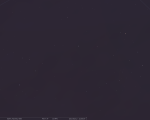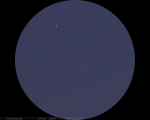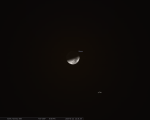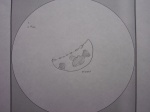January 21, 2016 January 21, 2016
Posted by orionrising in Observing.Tags: alhena, binoculars, moon, orion, pleiades
add a comment
After a long string of cloudy nights, tonight there was finally a clearing. The wind was minimal but it was still chilly. Went to the neighborhood park and observed from there for the first time. It was brighter there than I expected, several floodlights were installed and the surrounding buildings and school contributed to the light pollution as well. The moon was high up in the sky, almost full. Through my 10x50s it was a splendid sight. To its bottom left was a star, Alhena. This star is part of the constellation Gemini, one of the prominent winter constellations.
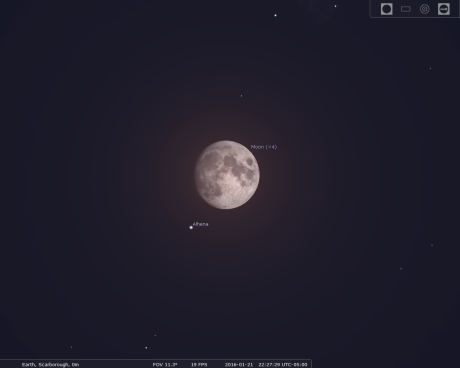
According to Wikipedia Alhena is the third brightest star in the constellation.
Also had a great naked eye view of Orion, but the constellation is already past its prime as we are approaching February. Through binoculars, the Orion Nebula was briefly visible but still the moon and surrounding light hampered its splendor.
Finally toured the nearby Pleiades before heading home. Looking forward to an exciting year of astronomy.
February 12, 2011 February 12, 2011
Posted by orionrising in Observing.Tags: arrows, geese, moon, taurus
3 comments
NB: The magnification of this image is different from custom this time, covering a FOV of ~7 Degrees, to capture both arrowheads at the same time.
Object: Stars
Site: Front Yard
Seeing: Good
Transparency: Great
Type: Deep-Sky
Constellation: Taurus
Magnification: 10x
FOV: 4.8 Degrees
Observing Time: 9:40-9:55 pm
Notes: With clouds bordering the horizon, it was slightly warmer tonight, so I decided to observe the northern areas of the Orion/Taurus constellation border. Found a fascinating set of two ‘arrows’ of moderately faint stars, one about 1.5 times bigger than the other. They coincidentally both point in the same direction, towards the waxing gibbous moon about 8 degrees to the right. A magnificent sight, a “fast forward” sign in the skies. To be honest, my first impression was two flocks of geese migrating north/south as the seasons change. A subtle reminder that spring (and warmer weather) is near! What about your first impressions? Let’s hear about it in the comments!
May 23, 2010 May 28, 2010
Posted by orionrising in Observing.Tags: corvus, crater, moon, sun, virgo
4 comments
Object: Moon
Site: Front Yard
Seeing: 1
Transparency: Poor
Type: Solar System Object
Size: 32′
Magnitude: -11.96
Constellation: Corvus
Magnification: 10x
FOV: 4.8 Degrees
Observing Time: 9:50 pm – 10.08 pm
Notes: Moon in Waxing Gibbous Phase. This weekend is Victoria Day Weekend, hoping to see a fireworks show too (but alas, none show up even though I hear plenty of popping). The edge of Mare Imbrium was seen in decent definition. A group of smaller craters near the bottom of the terminator were also visible. No bright stars visible near the moon through binoculars tonight. As for the atmospheric conditions, seeing is horrible and the transparency leaves something to be desired, but extremely bright and big objects like the moon are seldom affected. Atmospheric turbulences have a much greater effect on stars and deep-sky objects, like galaxies. We see the moon has phases, because of its motion around the Earth. An interesting fact is that the light reflected off from the moon will always be coming from the sun; by doing a quick triangulation between the sun, earth, and the moon, it is easy to get an ethereal feeling of the geometry of these three important bodies in space. Tonight, the moon is halfway between Corvus and Virgo, two adjacent constellations in the celestial sphere.
May 20, 2010 May 22, 2010
Posted by orionrising in Observing.Tags: HIP 55713, HIP 56500, Leo, mars, moon, reference point, saturn
8 comments
Object: Stars
Site: Front Yard
Seeing: Good
Transparency: 3
Type: Deep-Sky
Constellation: Leo
Magnification: 10x
FOV: 4.8 Degrees
Observing Time: 10:40 pm – 10:58 pm
Notes: Clothesrack-style organization of four stars: two from Leo the Lion, HIP 56500, HIP 55713. Moon was out tonight too, in First Quarter. Saturn and Mars were in the sky as well, Saturn sporting a creamy-yellow hue as always. Very warm weather the past day, but it’s more comfortable now. All four stars were bluish-white. At first it was difficult to find a decent reference point for this arrangement of stars, so it got lost easily and I spent a good minute trying to find it again. I need to practice my star-hopping skills. This is part of the training that binoculars gives to a stargazer; with a telescope it is even easier to become utterly lost. With practice, even faint stars can become signposts to finding the objects you want, not just the bright stars.
March 30, 2010 April 26, 2010
Posted by orionrising in Observing.Tags: galileo, moon, spica
add a comment
Object: Moon
Site: Backyard
Seeing: Good
Transparency: 4
Type: Solar System Object
Size: 1.2 Degrees
Magnitude: -12.33
Constellation: Virgo
MagnificatioN: 10x
FOV: 4.8 Degrees
Observing Time: 10:30 pm – 10:35 pm
Notes: First time looking at the stars from the backyard since I purchased my binoculars, and this was also the first time I saw the Full Moon through binoculars, very exciting! First impressions: more than ever I realized that the moon was a chunk of rock and not some ethereal glowing body (as naked-eye perception would tell me)…I can imagine Galileo’s shock when he first looked at the Moon through his telescope very long ago. Even though I’ve been studying science since I was a child, and everywhere from books to my mind I know that the Moon is made of rock, it is a refreshing experience to actually see it for myself. Binoculars bring out much more detail, and I could see many small irregularities in the whole circumference of the moon. Curiously, it seems less bright through binoculars than with the naked eye. Spica in the upper left (another Spring star). A little background on Galileo. An Italian astronomer in 17th century Europe, he is credited to be the first to use the telescope to look at celestial objects and played an integral role in the Scientific Revolution. He did not invent the telescope, as commonly misinterpreted. By observing irregularities in the moon, and sunspots on the sun, he put to rest the concept of perfect heavenly bodies– the moon and sun, he observed, were not perfect. By observing the moons of Jupiter orbiting around their planet, he confirmed that the Earth was not the Centre of Everything and had reason to support Copernicus’ heliocentric solar system model. This set off a political/religious dilemma, one that I won’t cover here. If interested, a quick search on Google will undoubtedly quench your interest. This past year, 2009, was the International Year of Astronomy in honor of the 400th anniversary of Galileo first looking through his telescope to the stars, and the legacy he left behind for generations of astronomers to come.
January 22, 2010 January 30, 2010
Posted by orionrising in Observing.Tags: moon
add a comment
Site: Front Yard
Seeing: Average
Transparency: 3
Type: Solar System Object
Size: 1.6 degrees
Magnitude: -10.73
Constellation: Pisces
Magnification: 10x
FOV: 4.8 degrees
Observing Time: 9:55 pm – 10:30 pm
Notes: Second time observing the moon, close to one month after my first observation with new binoculars! This time I was able to draw a relatively more detailed picture of the moon, seen here in first quarter (once I get the camera, I will post my sketch). Noticed how the top-right area was more smooth and contained more maria, while the bottom-left area contained less maria but was densely packed with terrae and impact craters. When the moon was formed 4.45 billion years ago, rocks of different densities and albedo values (the degree to which they reflect light) coalesced and formed the moon. Without going into much detail, the different densities and early volcanic activity gives rise to the broad spectrum of lunar features seen today, and the different reflection capabilities of the rocks give rise to the darkness of the maria and the brightness of the terrae. A thin layer of regolith (lunar dust) coats the surface of the moon. n Psc (3.80) at bottom right of FOV.
December 23, 2009 December 28, 2009
Posted by orionrising in Observing.Tags: binoculars, moon
3 comments
- My First Astronomy Sketch
- Photorealistic image in Stellarium
Object: Moon (Waxing Crescent)
Site: Front Yard
Seeing: Poor
Transparency: 2 (Clear Dark Sky Index)
Type: Solar System Object
Size: 1.6 degrees
Magnitude: -10.73
Constellation: Pisces
Optical Aid: Binoculars
Magnification: 10x
FOV: 4.8 degrees
Observing Time: 10:00-10:10 pm
Notes: First Light for my new Brunton 10 x 50 binoculars. First target was the moon, saw stunning detail! Most detail on the terminator, along the boundary of light striking the moon. Saw major Maria (Mare Fecunditatis, Mare Tranquilitatus, Mare Serenitatis, and Mare Vaporum). Moon was in Pisces at the time, lambda Psc seen in upper left of binocular field. Lambda Psc is magnitude 4.45, my new limiting magnitude with optical aid =D. So much more stars are seen with binoculars than with the naked eye! Star colors, such as on Rigel and Betelgeuse are clearly more defined. One thing is apparent; I need a stable mount. A quick glance at the Pleiades (spectacular) made this point clear. Everything was jumping around like fireworks! Observed Orion’s belt and his sword, saw the Orion Nebula (grey) which was pretty cool. Most of a nebula is made of gas. Yet its density in interstellar space would make one of the best vacuums on Earth, even if we flew straight into the nebula and collected this ‘gas’. I think I’ll see more detail once I figure out how to stabilize my binoculars. The moon seems to be an interesting target for the next few nights out.
Update: Typo for star name. Changed “Gamma Psc” to “Lambda Psc”
